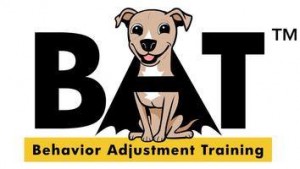As a modern dog trainer, you most likely enjoy learning about new techniques, or new twists on more classic techniques. If you have not yet heard of Behavior Adjustment Training (BAT) by Grisha Stewart, you are in for a treat. This will be the first of a three-part series discussing BAT, its applications, and most common mistakes made by trainers/owners.
BAT My Dog? What?
Grisha developed BAT after studying similar techniques and seeing how they could be tweaked to improve upon them. Her own reactive dog, Peanut, was very fearful of people, and she was seeking a way to help him live his life safely and happily. She is a firm believer in force-free training and empowering dogs, so she wanted a technique that would teach Peanut to acclimate to and even learn to like people, while always giving him the option of approaching or moving away.
BAT Basics
BAT is, quite simply, allowing your dog to make choices. Permitting dogs to make choices empowers them, making them more confident. So often, people want to control every aspect of their dog’s lives, thereby shutting their dogs down because they have learned that communication of their needs will just be ignored. A conscientious trainer will help people learn where they can offer some leeway to their dogs and allow them to express their needs safely.
BAT can be quite dull to watch to the untrained eye! In short, what it looks like is a dog wandering around on a long leash in an open area, occasionally glancing at whatever the item of their reactivity is. It’s much more complex though. As a trainer, you are teaching your clients to be lifeguards to their dogs. Let’s consider that the small waves at the beginning of the ocean are a visualization of the dog’s threshold and under threshold means being several yards up on the beach away from the ocean.
When the dog is safely under threshold, owners follow their dogs and allow them to move where they’d like, sniffing what they like, peeing where they like. In essence, being dogs. However, at a distance at which your dog is still comfortable is their trigger, what they are fearful of or frustrated towards or aggress towards. We’ll say it’s another dog for this article.
On The Shore Or Drowning?
So your client’s dog, Fido, notices his trigger, the other dog. If he glances at it and continues wandering around, that’s great. You’ve started at a safe distance. At some point though, Fido is going to meander closer to the other dog. Your job as a trainer is to help your client keep Fido from getting too close, beyond where he can handle it. Dogs can and will take themselves over threshold without our guidance. Essentially, keep him from drowning. We want Fido at a distance where he has noticed his trigger and is interested, but can easily disengage on his own.
If Fido starts getting overly interested or too close to the other dog, the lifeguard (his owner) needs to step in and save him. This is done through a variety of BAT leash skills that encourage Fido to turn away, rather than force him. What you do not want is to get to the point where your client needs to haul Fido away on a tight leash.
A “perfect” BAT session should consist of Fido being able to explore his area and gather information about the other dog, on a nice loose long line. Fido will sniff around the ground a little bit and then perhaps air scent the dog. Because he is not too close, he will return to calm exploration of his area. When permitted to move freely, you will see Fido approach the other dog in a gentle curve, without anxiety, fear, aggression, etc. As Fido sniffs his way slowly to the other dog, his handler will get more involved, keeping him from going faster than he can safely and calmly manage. With the help of his handler, Fido won’t get closer than he can handle, but he does notice his trigger. Your client will only guide Fido if he starts stepping off the beach and into the water, getting too close to his trigger.
Stay tuned for part two of this three part series on BAT!
Want To Learn More?
BAT is very complex and one little blog does not do it the justice it deserves. To learn more, you can watch a lovely free BAT Overview video that Grisha offers.
You can also watch a full 2 hour BAT Intro Webinar that Grisha put out. It is $29 but well worth the money if BAT is something you’d like in your toolbox.
Finally, to get the full immersion and become more proficient and comfortable in its use, you can take an online course called BAT 101.
Get Dog Training Business Tips!
Receive valuable dog training business tips and resources every week! Subscribe to The Modern Dog Trainer now by submitting your name and email below.
[mc4wp_form]





Thanks for sharing this knowledge as it is very informative.